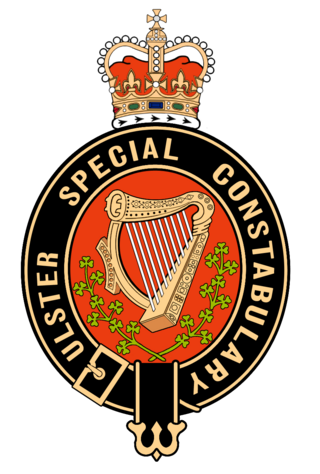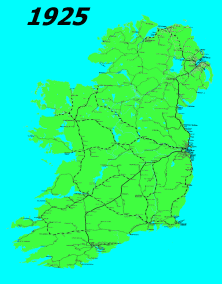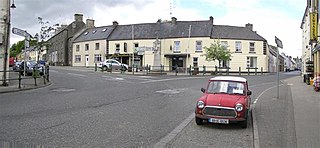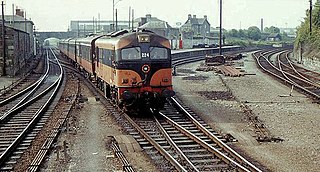
County Fermanagh is one of the thirty-two counties of Ireland, one of the nine counties of Ulster and one of six counties of Northern Ireland

The Royal Ulster Constabulary (RUC) was the police force in Northern Ireland from 1922 to 2001. It was founded on 1 June 1922 as a successor to the Royal Irish Constabulary (RIC) following the partition of Ireland. At its peak the force had around 8,500 officers, with a further 4,500 who were members of the RUC Reserve.

Dundalk is the county town of County Louth, Ireland. The town is on the Castletown River, which flows into Dundalk Bay on the east coast of Ireland. It is halfway between Dublin and Belfast, close to the border with Northern Ireland. It is surrounded by several townlands and villages that form the wider Dundalk Municipal District. It is the seventh largest urban area in Ireland, with a population of 43,112 as of the 2022 census.

Clones is a small town in the west of County Monaghan in Ireland. The area is part of the Border Region in the Republic of Ireland, earmarked for economic development by the Irish Government due to its currently below-average economic situation. The town was badly hit economically by the Partition of Ireland in 1921 because of its location on the border with County Fermanagh in Northern Ireland. The creation of the Irish border deprived it of access to a large part of its economic hinterland for many years. The town had a population of 1,680 at the 2016 census.

The Ulster Special Constabulary was a quasi-military reserve special constable police force in what would later become Northern Ireland. It was set up in October 1920, shortly before the partition of Ireland. The USC was an armed corps, organised partially on military lines and called out in times of emergency, such as war or insurgency. It performed this role most notably in the early 1920s during the Irish War of Independence and the 1956–1962 IRA Border Campaign.

The history of rail transport in Ireland began only a decade later than that of Great Britain. By its peak in 1920, Ireland had 3,500 route miles (5,630 km). The current status is less than half that amount, with a large unserviced area around the border area between Northern Ireland and The Republic of Ireland.

Rail transport in Ireland is provided by Iarnród Éireann in the Republic of Ireland and by Northern Ireland Railways in Northern Ireland.
Events from the year 1922 in Ireland.

Pettigo, also spelt Pettigoe, is a small village and townland on the border of County Donegal, Republic of Ireland, and County Fermanagh, Northern Ireland. It is bisected by the Termon River which is part of the border between the Republic of Ireland and Northern Ireland.

The Great Northern Railway (Ireland) (GNR(I) or GNRI) was an Irish gauge (1,600 mm (5 ft 3 in)) railway company in Ireland. It was formed in 1876 by a merger of the Irish North Western Railway (INW), Northern Railway of Ireland, and Ulster Railway. The governments of Ireland and Northern Ireland jointly nationalised the company in 1953, and the company was liquidated in 1958: assets were split on national lines between the Ulster Transport Authority and Córas Iompair Éireann.

The Belfast–Dublin Main Line is a main and busiest railway route on the island of Ireland that connects Dublin Connolly station in the Republic of Ireland and Belfast Lanyon Place station in Northern Ireland. It is the only railway line that crosses the Republic of Ireland–United Kingdom border.

Cullaville or Culloville (from Irish Baile Mhic Cullach, meaning "MacCullach's townland" or McCulloch's ville or town is a small village and townland near Crossmaglen in County Armagh, Northern Ireland. It is the southernmost settlement in the county and one of the southernmost in Northern Ireland, straddling the Irish border. In the 2001 Census it had a population of 400 people. The village is on a busy crossroads on the main Dundalk to Castleblaney road ; three of the roads lead across the border and the fourth leads to Crossmaglen.

Irish North Western Railway (INW) was an Irish gauge railway company in Ireland.
Armagh railway station was a railway station that served Armagh in County Armagh, Northern Ireland.
The Londonderry and Enniskillen Railway (L&ER) was an Irish gauge railway in Ireland.
Cavan railway station in Swellan in Cavan Town was a former station on the Inny Junction to Cavan branch of the Midland Great Western Railway, Ireland.
The Enniskillen and Bundoran Railway (E&BR) was an Irish gauge 5 ft 3 in railway company in north-west Ireland. It linked Bundoran and Ballyshannon on the Atlantic coast of Donegal with the Londonderry and Enniskillen Railway (L&ER) at Bundoran Junction in Fermanagh. The line was opened in 1868 and closed in 1957.

Bundoran railway station served Bundoran in County Donegal in the Republic of Ireland.

Monaghan railway station was on the Ulster Railway designed by Sir John Macneil located in the Republic of Ireland.

The Troubles of the 1920s was a period of conflict in what is now Northern Ireland from June 1920 until June 1922, during and after the Irish War of Independence and the partition of Ireland. It was mainly a communal conflict between Protestant unionists, who wanted to remain part of the United Kingdom, and Catholic Irish nationalists, who backed Irish independence. During this period, more than 500 people were killed in Belfast alone, 500 interned and 23,000 people were made homeless in the city, while approximately 50,000 people fled the north of Ireland due to intimidation. Most of the victims were Nationalists (73%) with civilians being far more likely to be killed compared to the military, police or paramilitaries.















